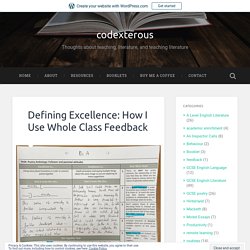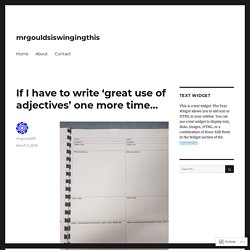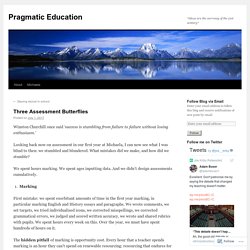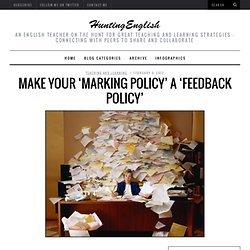

Defining Excellence: How I Use Whole Class Feedback – codexterous. I first encountered whole class feedback several years ago and was instantly captivated.

And what’s not to love? It promises a significant reduction in workload, no longer spending countless hours huddled over a slow burning lamp with pen in hand (forgive the Dickensian rhetorical flourish) whilst simultaneously, even miraculously, improving student outcome. How can we ensure teachers receive effective feedback? Good feedback can be a powerful way to help teachers to become (even) more effective, writes Rob Coe We know effective feedback is incredibly powerful for students’ learning (Hattie and Timperley, 2007) and supporting task performance much more generally (Kluger and DeNisi, 1996; London, 2003).

This is as true for teachers as for students. But are teachers actually receiving effective feedback? My own PhD research, more than 20 years ago (Coe, 1998), was on the impact of giving teachers feedback. The evidence, then and now, suggests that this can be a powerful way to improve outcomes. If we want our students to be able to do hard things (eg use capital letters properly, present complex arguments or do column subtraction), we don’t just describe the final product. Teacher learning is just like every other kind of learning. No More Marking – Institute for Effective Education. Written comments: three simple rules (and a fourth) – James Durran. Number #1 in an occasional series of short posts on feedback, appearing in no particular order When delivering training on feedback, I don’t tend to spend too much time on written comments: the focus tends to be on oral and whole class feedback, classroom culture, questioning techniques, editing and redrafting, ‘work-shopping’ approaches and so on.

If anything, it tends to focus on ways to minimise written ‘marking’. However, many teachers are bound by policies which insist on regular written, prose comments; many are even tied down to formulae such as ‘three stars and a wish’, or ‘WWW, EBI’. So here are some simple ‘rules’ for such written comments, which I have found helpful. (Note: there is nothing startling here, but it all seems to need revisiting!) No Written Marking. Job Done. - onebetweentwo. EEF-Flash-Marking-Implementation-Logic-Model. No Written Marking. Job Done. - onebetweentwo. If I have to write ‘great use of adjectives’ one more time… – mrgouldsiswingingthis. Friday. 3pm.

Bye you lot, have a nice weekend. Have you remembered your book bag? Got your jumper? No he’s stayed on green all day… Back into classroom. 25 Maths books. 25 English books. Up and down the country, this scene is repeated. So my school questioned it too. So we stopped. HT proposed something new. And we realised, as we dropped down on the rollercoaster track, this was a brilliant idea and we should have done it a long time ago. Marking is now half an A4 page per lesson. A box for More Able, which isn’t necessarily your Greater Depth-elect children as this can change depending on subject and topic within a subject. Finally… the big one. ‘Next steps’. Esse Quam Videri – A blog about education. Follow me on twitter @HeatherBellaF. The Holy Grail of Marking – Peter Richardson – Medium. Back in 2014 I wrote a piece on why I felt marking was of little value.

I believed that the amount of time spent on marking was disproportionate to the impact it gave. I believe this now more than ever, as: If the child can’t read the comment, it’s a waste of timeIf the child can read the comment, but doesn’t understand what it means, it’s a waste of timeIf the child understands what it means but has no clue about how to improve, it’s a waste of timeIf the child understands how to improve but isn’t given time to do so, it’s a waste of timeIt the child is given time to improve, but is focused on the context of the marked piece of work rather than the knowledge, skills or understanding they were learning, it’s a waste of time The problem at the time was I couldn’t see a way forwards that didn’t involve lots of comments aimed at individuals.
Marking like this is like trying to squash water. I mention wellbeing here. The holy grail of marking. I then read this and this from Gov.uk. Bebcmat teaching learning assessment policy v1 7 may 2016. Giving feedback the ‘Michaela’ way. Three Assessment Butterflies. Winston Churchill once said ‘success is stumbling from failure to failure without losing enthusiasm.’

Looking back now on assessment in our first year at Michaela, I can now see what I was blind to then: we stumbled and blundered. What mistakes did we make, and how did we stumble? We spent hours marking. We spent ages inputting data. And we didn’t design assessments cumulatively. Marking First mistake: we spent exorbitant amounts of time in the first year marking, in particular marking English and History essays and paragraphs. The hidden pitfall of marking is opportunity cost. Marking. Feedback Marking 3.JPG 5,120×6,176 pixels. Marking policy.pdf. Feedback-marking-for-website.pdf. Make your ‘Marking Policy’ a ‘Feedback Policy’ Marking workload getting on top of you?

Many schools, and departments, have been reflecting about their marking policies ever since OFSTED declared more than a healthy interest in scrutinising books. Progress over time has rightly been identified as more important than single lesson snap shots – of course, that evidence if best found in ongoing student work and the attendant formative assessments. This has combined with greater scrutiny of standards of literacy, particularly writing. I have no problem with this; as you would expect from an English teacher.
I think it is of paramount importance to have the highest standards for writing across the curriculum. Firstly, I think it is important to understand the OFSTED context, so I can then move beyond it to the more important context: the pedagogy and the learning. “A basic way of reviewing pupils’ work is to select an extended piece of writing from near the beginning of a pupil’s book (or folder of work). Bannockburn%20feedback%20marking%2012-13_1. Lamberhurst Feedback_and_Marking_Policy.